Healthy high-protein snacks are essential components of a balanced diet. They offer a valuable energy boost between meals while contributing to muscle repair and growth. Protein is a key macronutrient necessary for the maintenance of bodily functions. Incorporating it into snacks can enhance feelings of fullness. This helps to curb appetite and avoid overindulgence in less nutritious options.
For busy individuals, students, athletes, or anyone looking to maintain a healthy lifestyle, high-protein snack options are varied and easily accessible. They range from dairy and egg-based options, such as Greek yogurt and hard-boiled eggs, to plant-based choices like roasted chickpeas and nut butters.
Understanding the criteria for what qualifies as a healthy high-protein snack is crucial for making informed dietary choices. A snack that is high in protein should also be balanced with other nutrients, minimize added sugars, and be appropriate in portion size. Recipes and meal ideas that prioritize high-quality protein sources are instrumental in developing a satisfying and sustainable eating pattern. Innovative methods to enhance the protein content of traditional snacks not only add nutritional value but also cater to diverse tastes and preferences, ensuring that there is a high-protein snack for everyone.
Key Takeaways
- Protein-rich snacks support muscle health and can help regulate hunger levels.
- A variety of options, from dairy and plant-based to meat and seafood, cater to different dietary needs.
- Selecting snacks with high protein and balanced nutrition aids in maintaining a healthy and satisfying diet.
Proteins and Their Benefits
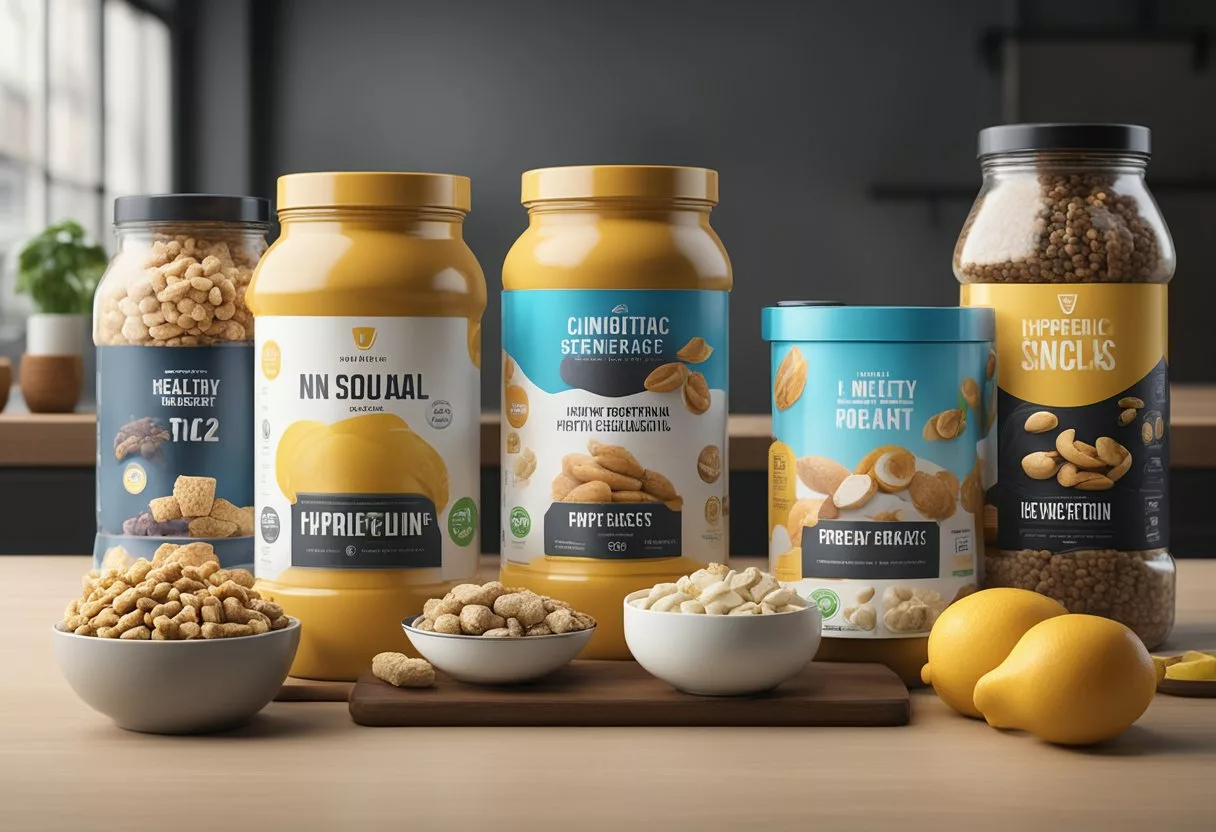
Protein plays a pivotal role as a macronutrient in human nutrition, acting as the building block of muscles and a crucial component for metabolism and overall health.
The Role of Protein in Nutrition
Protein is essential in the diet, serving as one of the three macronutrients that provide energy and calories to the body. It is made up of amino acids, which are the fundamental units that perform a variety of functions in the body, including repair and maintenance of tissues. An individual’s protein needs differ based on their age, weight, and level of physical activity. A balanced diet must contain an appropriate amount of protein to ensure that the body can build and repair muscle tissue effectively and maintain a healthy metabolism.
Health Benefits of Protein
Protein offers numerous health benefits beyond its role in muscle synthesis. It plays a vital part in:
- Muscle growth and repair: Adequate protein intake is crucial for both the development of muscle mass and the repair of muscle tissue post-exercise.
- Metabolic health: As a macronutrient, protein has a higher thermic effect than fats or carbohydrates, meaning its digestion burns more calories, which can aid in weight management.
- Satiety and energy levels: Protein-rich foods generally provide a longer feeling of fullness, which can help in controlling calorie intake. Additionally, it contributes to sustained energy levels throughout the day.
By incorporating an adequate amount of protein into the diet, individuals can ensure that they are supporting their body’s needs for maintenance, function, and overall health.
Criteria for Healthy High-Protein Snacks
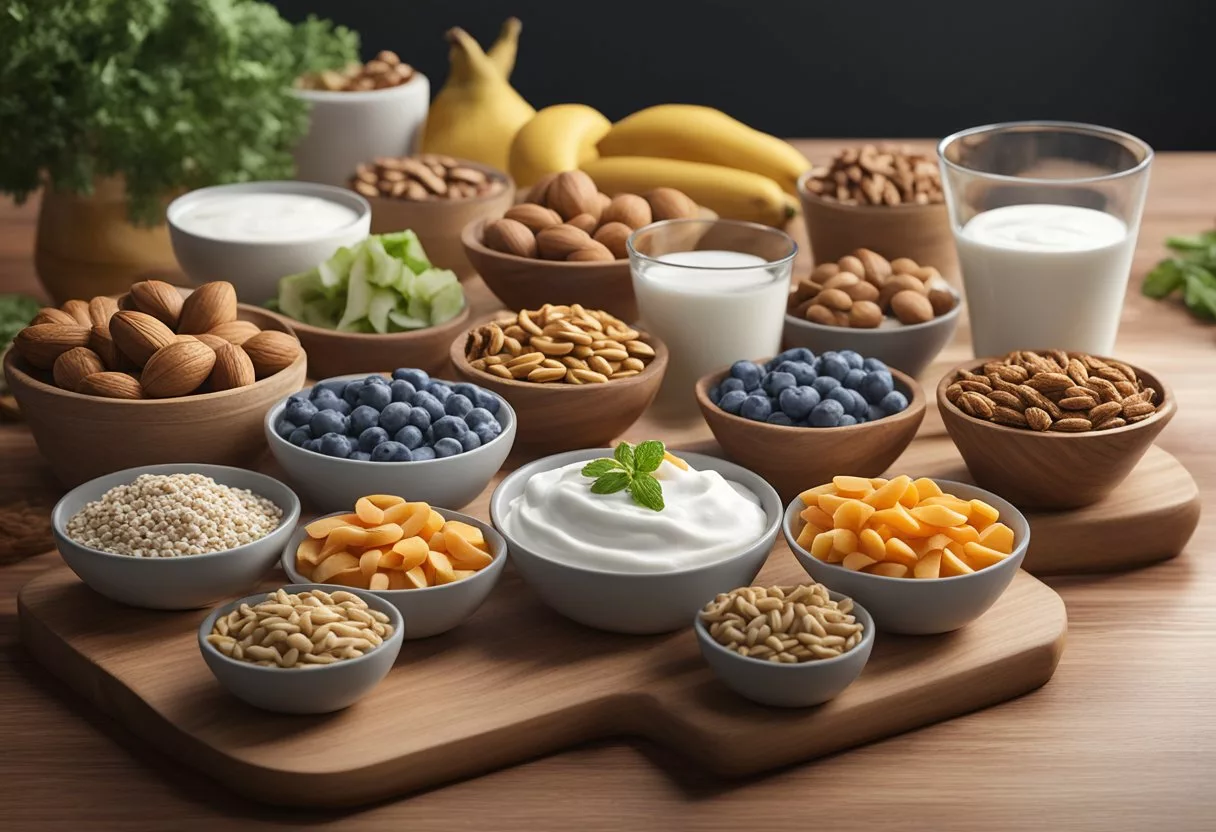
Choosing healthy high-protein snacks involves careful consideration of their nutritional content. These snacks should have a balanced ratio of macronutrients, appropriate calorie content, and a good amount of dietary fiber to ensure they contribute to a well-rounded diet.
Balancing Macronutrients
The ideal snack provides a good balance of proteins, carbohydrates, and fats. A high-protein snack should contain quality protein sources like lean meats, legumes, or dairy. It’s also vital to include healthy fats such as those found in nuts, which can enhance satiety. One should be wary of snacks with high sugar content, as they can lead to energy spikes and crashes.
Considering Calorie Content
High-protein snacks should be filling but not overly calorific. This is important for managing overall daily calorie intake. An appropriate snack typically ranges between 150-250 calories, providing enough energy to satisfy hunger without excess.
The Importance of Fiber
Fiber is crucial for digestive health and can help one feel full longer, which is particularly beneficial in a snack. Selecting snacks with high fiber content, such as fruits or whole grains, can support one’s overall health and assist in the regulation of blood sugar levels.
Dairy and Egg-Based Protein Snacks
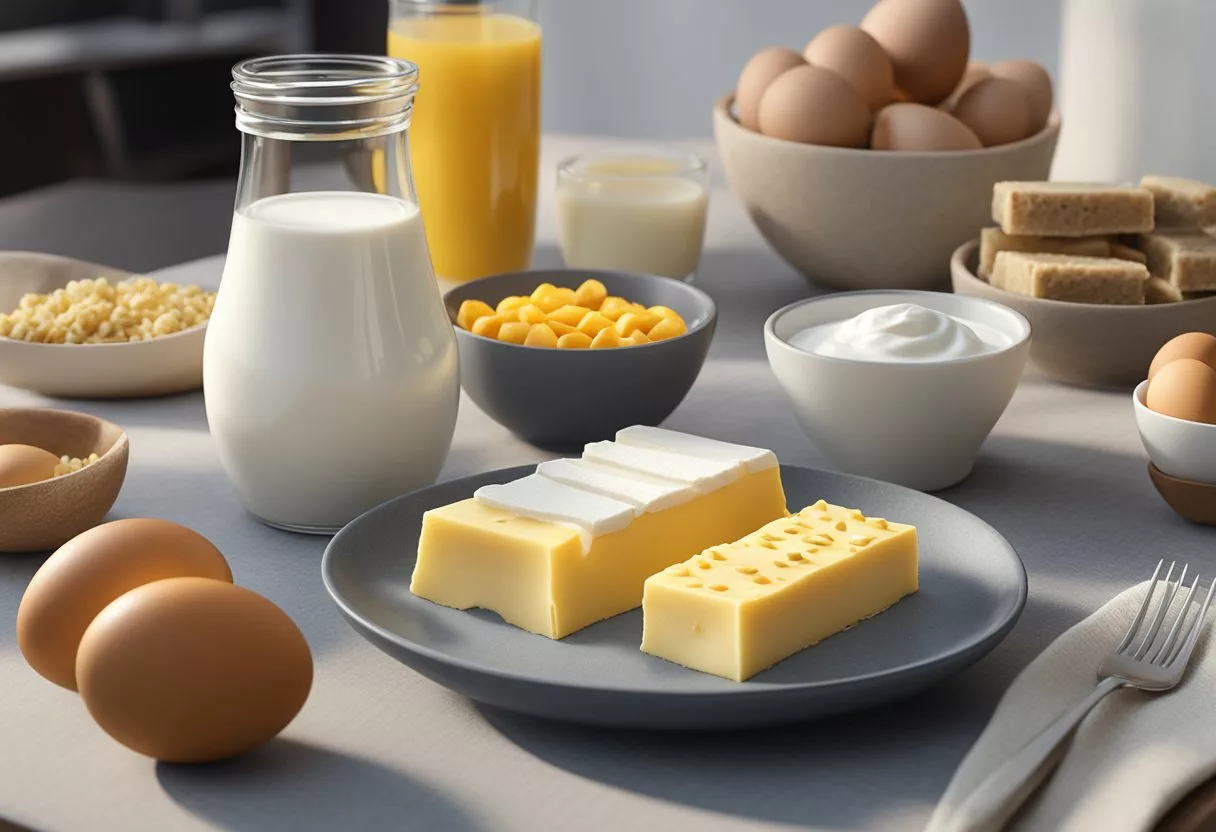
Dairy and egg-based snacks offer a high-quality source of protein along with essential nutrients like calcium and vitamins. They are both convenient and versatile options for a healthy diet.
Cheese Varieties
Cheese is a nutrient-dense snack that provides a significant amount of protein, calcium, and other vital nutrients. For those seeking a protein boost, options like cottage cheese pack as much as 28 grams of protein per cup. Alternatively, string cheese offers a portable and portion-controlled choice.
- Cottage Cheese: Rich in casein, a slow-digesting dairy protein that can help curb hunger.
- Mozzarella: A single stick of part-skim mozzarella can contain 8 grams of protein.
Greek Yogurt and Its Versatility
Greek yogurt stands out for its creamy texture and adaptable flavor that works well in both savory and sweet dishes. It typically contains approximately 17 grams of protein per 6-ounce serving. Greek yogurt can be enjoyed plain or as a part of a recipe, such as a smoothie or parfait.
- Plain Greek Yogurt: A blank canvas for add-ins like fruits, nuts, and honey.
- Greek Yogurt Parfait: Layer with granola and berries for a satisfying snack.
Eggs as a Convenient Protein Source
Eggs are an incredibly versatile and convenient source of high-quality protein. One large egg contains about 6 grams of protein along with a variety of nutrients. Boiled eggs, whether soft or hard-boiled, are especially convenient for on-the-go snacking.
- Boiled Eggs: A simple and quick way to prepare eggs that can be made in advance.
- Hard-Boiled Eggs: Easy to pack and perfect for a protein-rich snack anytime.
Plant-Based Protein Snack Options
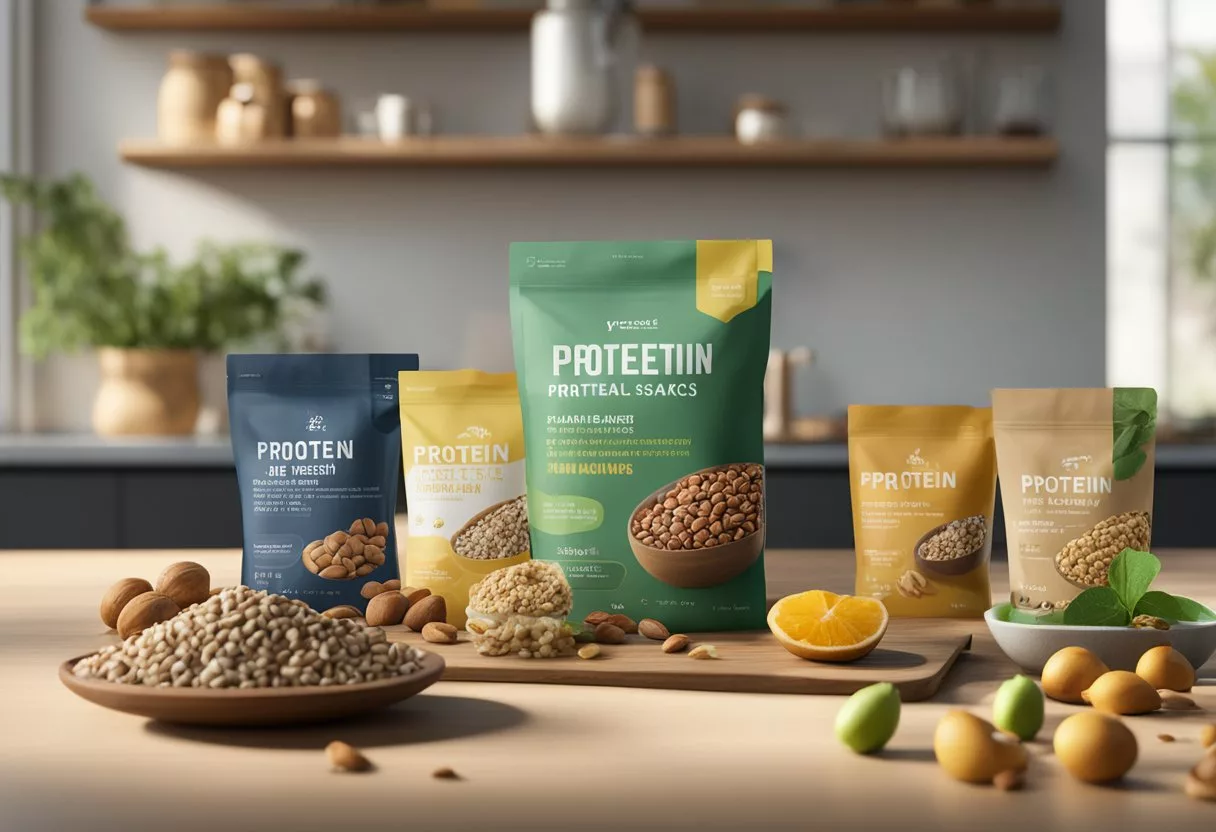
Plant-based diets can deliver all the necessary nutrients, including protein, when carefully planned. High-protein snacks are an excellent addition to a vegan or vegetarian lifestyle, providing energy and supporting muscle repair.
Nuts and Seeds
Nuts and seeds offer not only protein but also healthy fats and fiber, contributing to satiety and balanced nutrition. Almonds and pistachios are top choices with roughly 6 grams of protein per ounce. They are also good sources of iron and healthy fats. Chia seeds and flaxseeds can be sprinkled over salads or yogurt, packing over 5 grams of protein in just 2 tablespoons, alongside an impressive amount of fiber.
- Examples of nuts and seeds high in protein include:
- Almonds
- Pistachios
- Chia seeds
- Hemp seeds (with links to tasty high-protein vegan snacks)
- Flaxseeds
Legumes and Beans
Legumes and beans provide a solid foundation for a plant-based diet, rich in protein and versatile in use. Chickpeas can be roasted for a crunchy snack or mashed into a delicious tahini-based hummus, providing about 7.25 grams of protein per half-cup serving. Black beans and lentils can also serve as protein-packed snack options, with the added bonus of essential minerals.
- Protein-rich legumes and beans include:
- Chickpeas
- Lentils (further explored for their high-protein content on Real Life Nutritionist)
- Black beans
Healthy Fats from Avocado and Olive Oil
Including healthy fats like avocado and olive oil into snacks not only contributes to the overall fat intake of a vegan or vegetarian diet but can also enhance the absorption of fat-soluble vitamins.
Avocadoes are a creamy snack choice that brings both protein and fiber to the table. Drizzle olive oil over avocados or into bean dips to enrich flavor and nutrient intake.
- Sources of healthy fats with protein include:
- Avocadoes
- Olive oil (highlighted in high-protein snacks that pack a lot of protein)
By incorporating nuts, seeds, legumes, beans, and sources of healthy fats into their snacks, individuals following a plant-based diet can efficiently meet their protein requirements. Each option also brings additional nutrients, making them healthy and integral components of a balanced diet.
Meat and Seafood Snacks
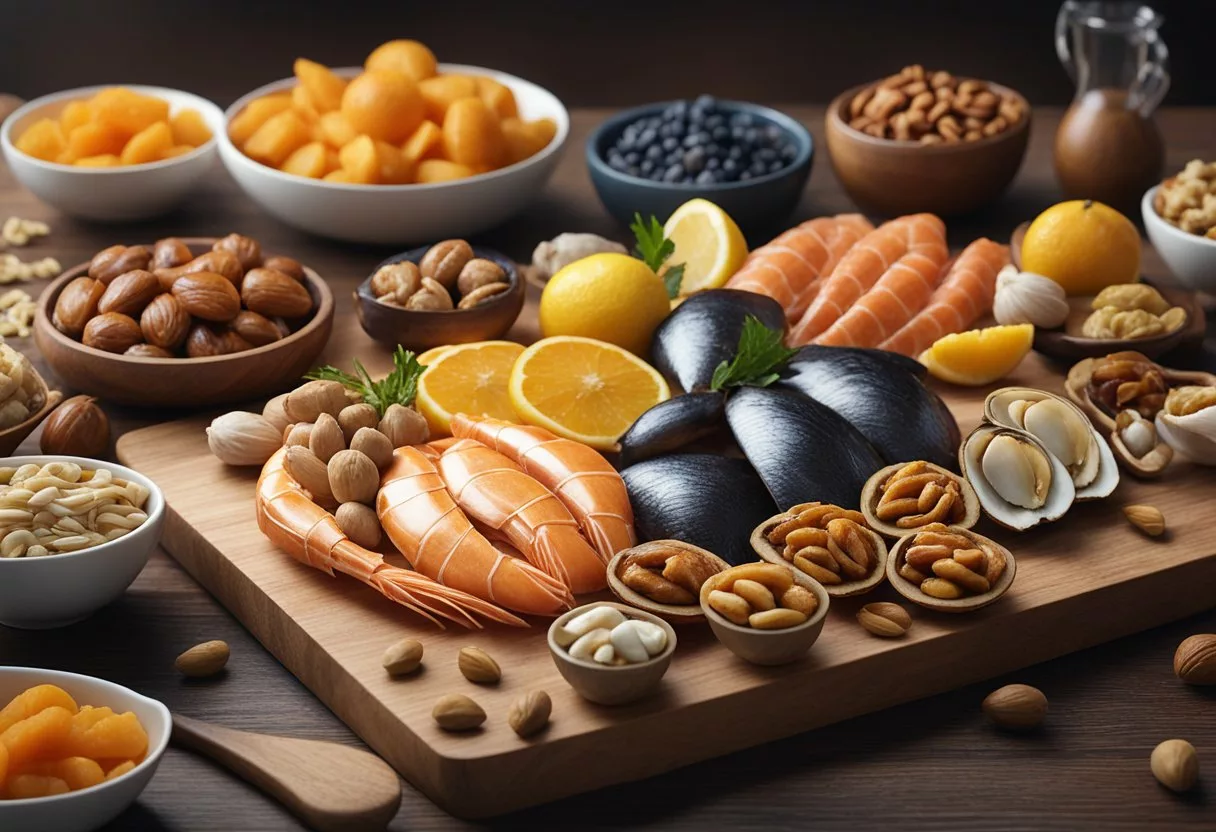
When considering high-protein snacks, meat and seafood options are excellent for providing both nutrients and flavor. They are particularly rich in essential amino acids and can provide a variety of health benefits when included in a balanced diet.
Jerky as a Protein-Rich Snack
Jerky, which includes varieties like beef jerky, is a convenient and high-protein snack. It’s made by drying lean cuts of meat, which concentrates the protein content.
An ounce of beef jerky can contain about 9.4 grams of protein, making it a satiating on-the-go option. Try to opt for jerky that has minimal added sugar and preservatives to keep things healthy. For a diverse range, check out 17 Healthy Meat Snacks for Carnivores and Protein-Lovers, where they explore different types of jerky and meat snacks for a healthy diet.
Fish: Omega-Rich Protein Source
Fish not only delivers high-quality protein but also a significant amount of omega-3 fatty acids, which are beneficial for heart health.
Options like tuna are portable when purchased in pouches or cans and can provide around 20 grams of protein per serving.
Additionally, fish like salmon can be made into snacks such as smoked salmon on whole grain toast for a quick bite. Incorporate fish into snacks for protein and the omega-3 benefits as highlighted in 23 High-Protein Snacks to Stay Full and Energized All Day by pairing with healthy fats and fibers.
Innovative Ways to Enhance Protein Content
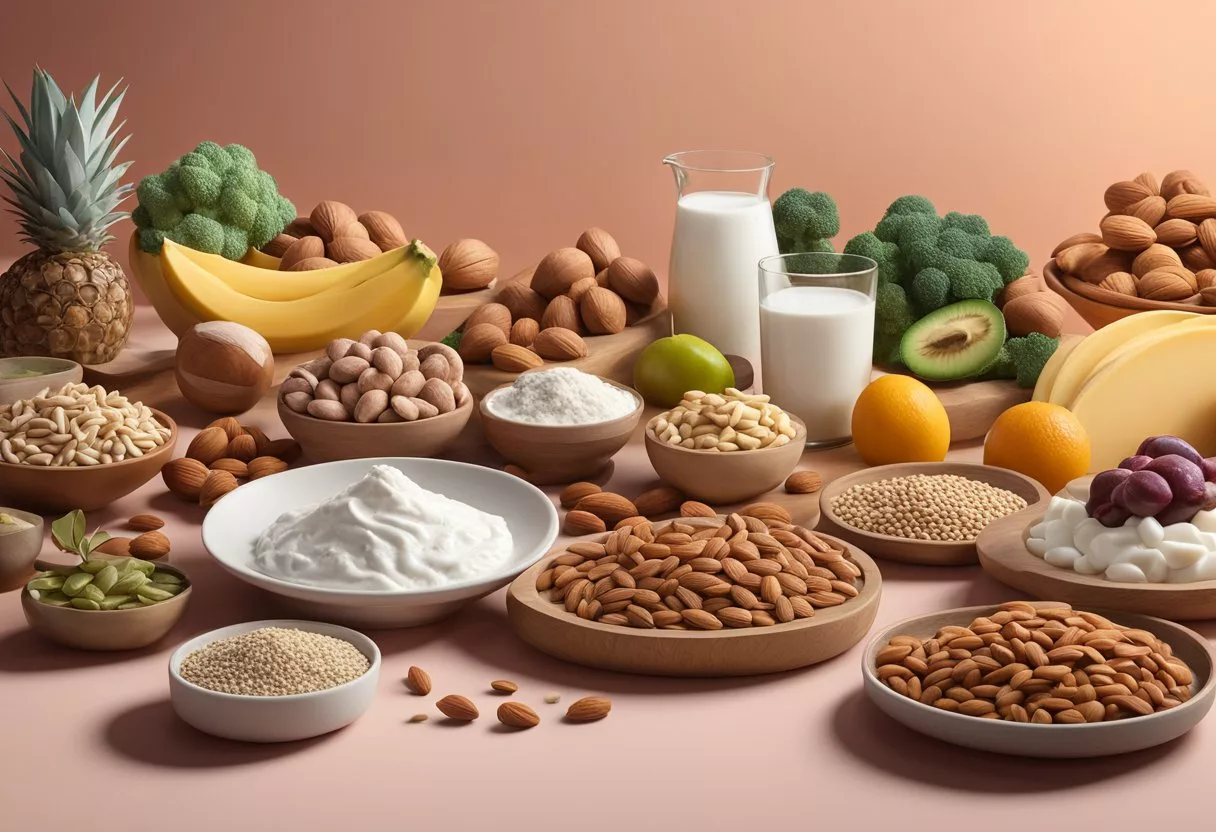
In the quest for healthy snacking, boosting protein intake can provide sustained energy and support muscle health. Two effective methods to augment protein in snacks are incorporating protein powder and utilizing nut butters and spreads.
Using Protein Powder
One can seamlessly increase the protein content in a variety of snacks by adding protein powder. This versatile ingredient blends well with both sweet and savory recipes.
For instance, protein powders can be a part of homemade energy bars or smoothies, providing a substantial protein boost per serving. Here are a few snack ideas enriched with protein powder:
- Protein-Packed Smoothies: Blend your favorite fruits with a scoop of protein powder for a refreshing and filling treat.
- Homemade Protein Bars: Mix oats, protein powder, honey, and your choice of nuts and seeds, then press into a pan and chill.
Protein powder can be plant-based, such as pea or rice protein, or animal-derived, like whey or casein, catering to different dietary preferences.
Nut Butters and Spreads
Nut butters, like peanut butter and almond butter, are excellent sources of protein that can transform simple snacks into satisfying, high-protein treats. They are not only packed with protein but also provide healthy fats and fiber. Here are some creative ways to incorporate them into your snacking routine:
- Celery with Nut Butter: Spread peanut butter over celery sticks for a crunchy and protein-rich snack.
- Nut Butter Dip: Use almond butter as a dip for apple slices or whole-grain crackers to increase your snack’s protein content.
- No-Bake Protein Balls: Combine nut butter, oats, honey, and protein powder to make delicious, no-bake protein balls that are convenient to eat on-the-go.
By choosing different nuts and seeds, one can enjoy a variety of flavors and additional nutritional benefits, such as essential minerals and antioxidants.
Recipes and Meal Ideas
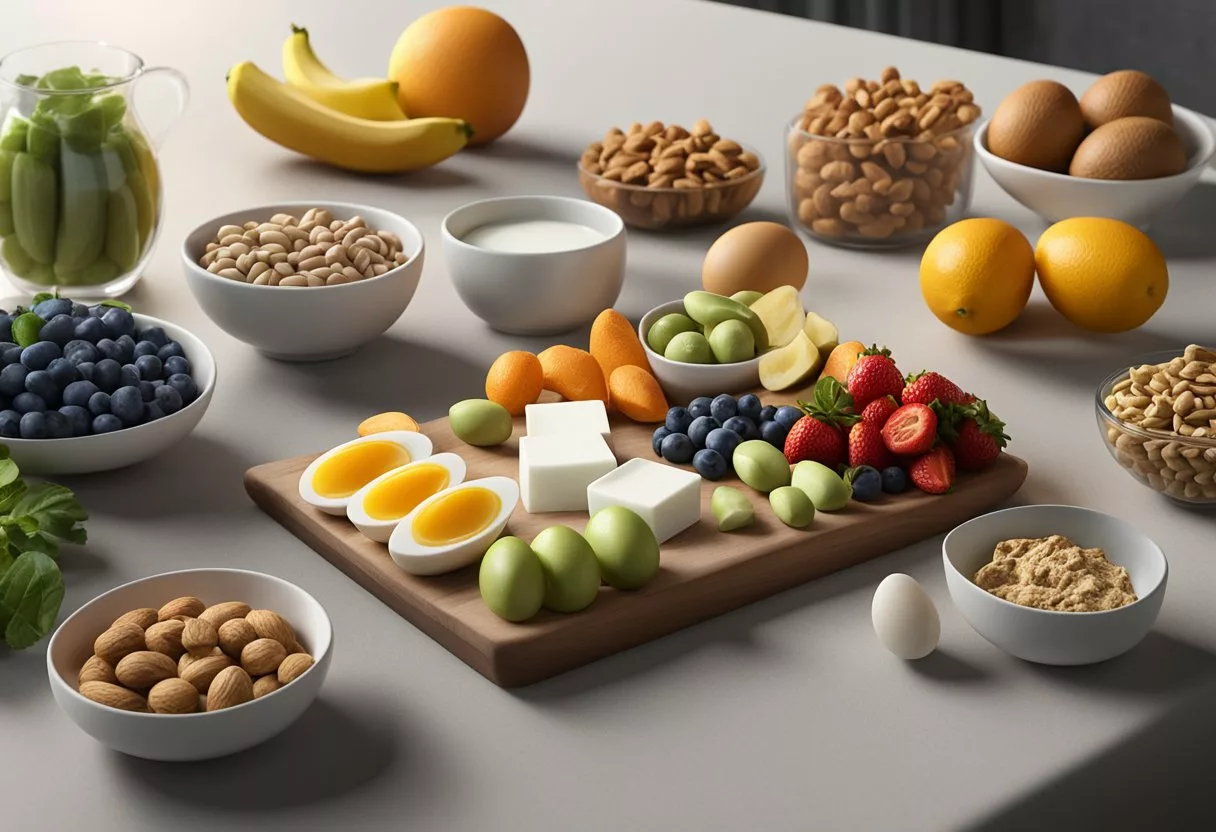
Incorporating high-protein options into daily meals can sustain energy levels and support muscle health. From morning to night, these meal ideas make it simple to include protein-rich foods in a balanced diet.
High-Protein Breakfast Options
- Oatmeal with a Twist: Start with a base of oatmeal and add a scoop of protein powder, a tablespoon of almond butter, and a sprinkle of chia seeds for an energizing breakfast. For recipes that incorporate protein into your morning oatmeal and keep flavors fresh, consider variations like these Easy High-Protein Snack Recipes.
- Greek Yogurt Parfaits: Layer Greek yogurt with granola and fresh berries. Greek yogurt is a powerhouse of protein and can boost the nutritional profile of your morning routine.
Protein-Packed Lunches
- Quinoa Salad Bowls: Quinoa is a complete protein and serves as an excellent base for a variety of salads. Combine with mixed greens, cherry tomatoes, cucumber, feta cheese, and a vinaigrette for a quick and nutritious lunch.
- Turkey and Cheese Roll-Ups: Swap out the bread and use turkey slices as wraps for cheese and veggies for a no-fuss lunch that’s rich in protein.
Dinner Ideas with High Protein
- Grilled Chicken or Fish: A simple, protein-rich dinner can consist of grilled chicken breast or fish such as salmon or tuna, complemented by steamed vegetables and a side of quinoa or brown rice.
- Stir-Fried Tofu: Tofu is an excellent source of protein for dinner and can absorb a myriad of flavors. Stir-fry with a mix of your favorite vegetables and a soy or teriyaki sauce for a fulfilling meal. For specific recipe instructions, you can expect delicious outcomes from these High Protein Recipes.
Portable Protein Snacks for On-the-Go
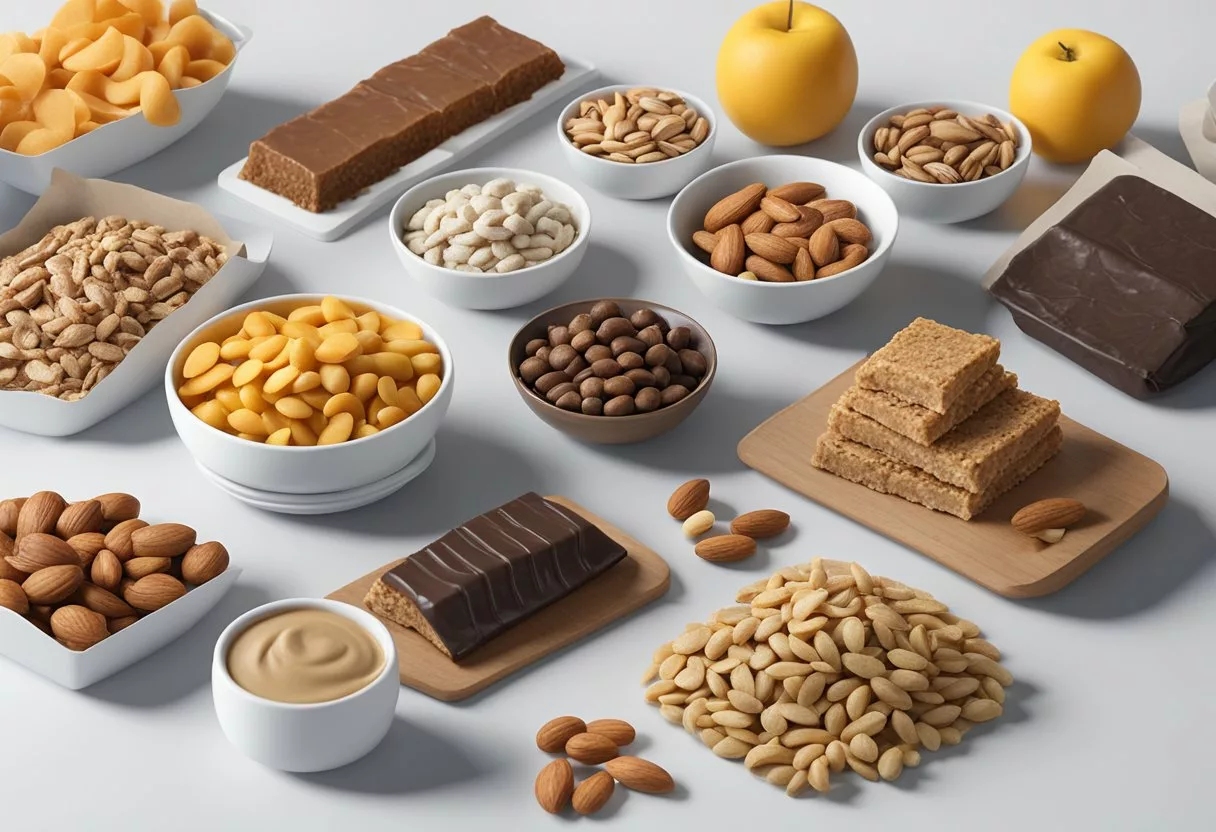
For those leading a busy lifestyle, maintaining a diet high in protein doesn’t have to be a challenge. The key is choosing snacks that are not only high in protein but also convenient to carry and consume when you’re on the move.
Protein Bars and Ready-to-Eat Packs
Protein bars are the quintessential on-the-go snack. They are compact, non-perishable, and come in a variety of flavors, meeting both nutritional and taste preferences. When selecting a protein bar, one should look for bars with a high protein content and low added sugars.
Examples of popular protein bar choices include:
- Quest Bars
- RXBARs
- KIND Protein Bars
In addition to protein bars, there are ready-to-eat packs that often include a balanced mix of proteins, carbohydrates, and fats. These packs may contain servings of lean meats, cheese, or hummus, and are designed to be mess-free and easily accessible.
Ready-to-eat packs to consider might include:
- Trail Mix with a higher proportion of nuts and seeds
- Single-serve packets of almond or peanut butter
Convenient Fruits and Nut Pairings
Combining nuts with fruits is another excellent way to get a quick protein fix along with fiber and essential vitamins. Nuts such as almonds, walnuts, and cashews are not only protein-rich but also provide healthy fats and micronutrients like magnesium.
Fruits that pair well with nuts include:
- Apple slices with almond butter
- A bag of mixed berries with a handful of walnuts
These fruit and nut pairings can be prepped in advance and carried in small containers or bags, making them a practical snack for those with even the busiest schedules. They offer a satisfying crunch along with a sweet counterpart, hitting multiple taste notes while providing sustained energy.
Making Smart Snack Choices
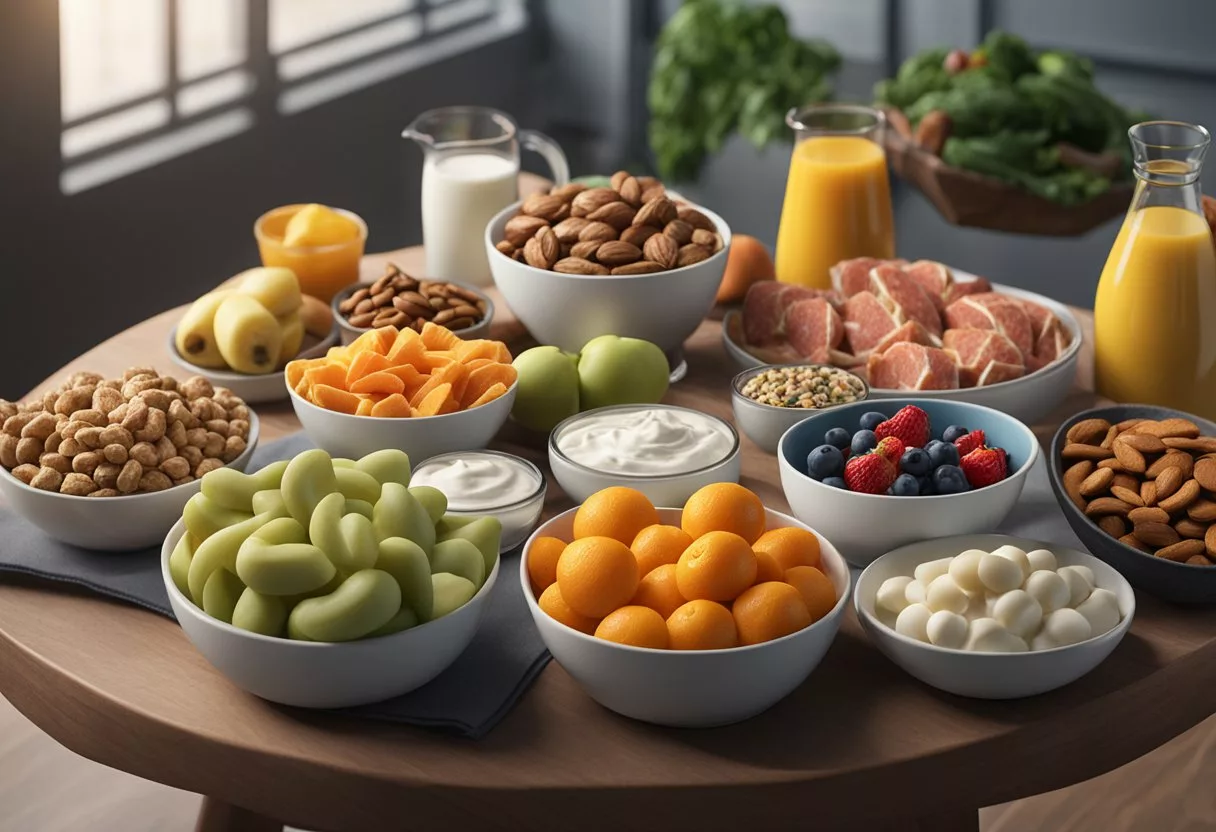
Choosing the right snacks can make a significant difference in one’s nutritional intake. It is not just about satisfying hunger pangs but also about ensuring that one gets a healthy dose of nutrients and remains satiated until the next meal.
Reading Nutrition Labels
When selecting snacks, it is vital to read nutrition labels carefully to understand the portion size and calorie content. Labels provide critical information about the nutritional value of the snack. This includes protein, fat, carbohydrates, and dietary fiber.
A snack high in protein can contribute to a feeling of satiety and support muscle repair and growth. They should look for snacks that contain beneficial nutrients while being low in added sugars and unhealthy fats.
- Example: A product may advertise as a high-protein option, yet one serving could also contain excessive calories or sodium. The skill is in choosing those that align with one’s dietary goals.
Portion Control
Understanding and adhering to portion control is crucial for maintaining a balanced diet. Oversized portions can lead to excess calorie consumption even with healthy snacks.
- Tips for Portion Control:
- Pre-measure snacks to avoid overeating.
- Use smaller plates or bags to keep portions in check.
- Avoid snacking directly from the package; it’s easy to eat more than intended.
To remain satisfied and ensure that snacks contribute positively to their diet, individuals should choose those that are nutrient-dense and satiating. A dietitian can provide personalized advice on portion sizes and snack choices that support health goals.
Health Considerations and Dietary Restrictions
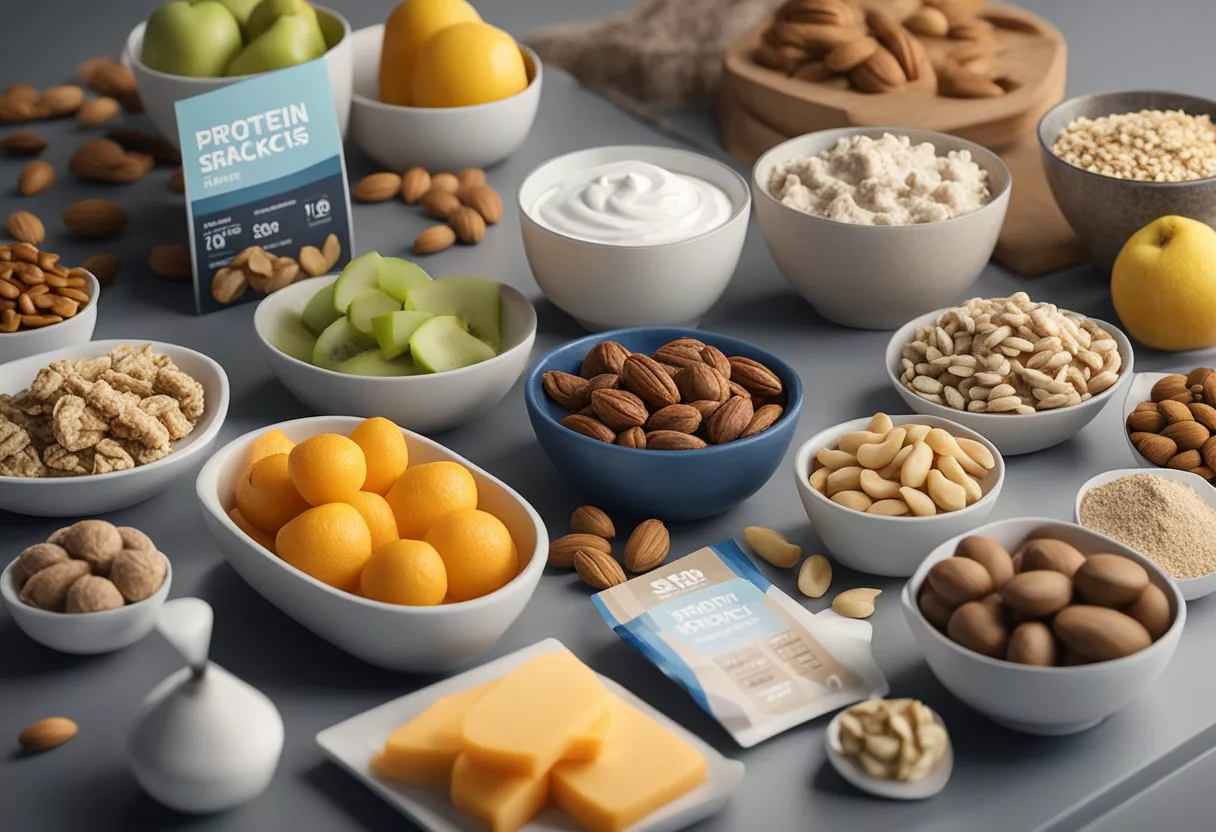
When considering high-protein snacks, one must take into account potential dietary restrictions and health considerations that vary among individuals. These factors include allergies, heart health, and digestive system needs.
Allergies and Intolerances
Allergies can have a significant impact on snack choices. For example, nuts are a common high-protein snack, yet they are also one of the most common allergens. Individuals with nut allergies can opt for seeds, such as pumpkin or sunflower, which provide a similar protein boost without the allergenic compounds.
On the other hand, intolerances, such as lactose intolerance, necessitate the avoidance of dairy-based snacks. This leads one to choose lactose-free options like almond milk yogurt or certain cheeses, which may be easier to digest.
Heart Health
For those prioritizing heart health, snacks low in saturated fats and sodium are key. High-protein options that support a healthy heart include lean meats like turkey slices, fish such as salmon that are rich in omega-3 fatty acids, and plant-based choices like legumes.
Snacks like low-sodium cottage cheese paired with fresh vegetables can also be a part of a heart-healthy diet.
Digestion and Gut Health
Maintaining digestion and gut health is crucial when consuming high-protein snacks. Foods that contain both protein and fiber promote a healthy digestive system.
Legumes, for instance, not only provide protein but also are rich in fiber which aids in digestion. Probiotic-rich snacks like kefir or Greek yogurt contribute to a balanced gut microbiome.
Furthermore, incorporating snacks with prebiotics—found in foods like bananas and oats—helps to foster beneficial bacteria in the gut.
The Science of Satiety
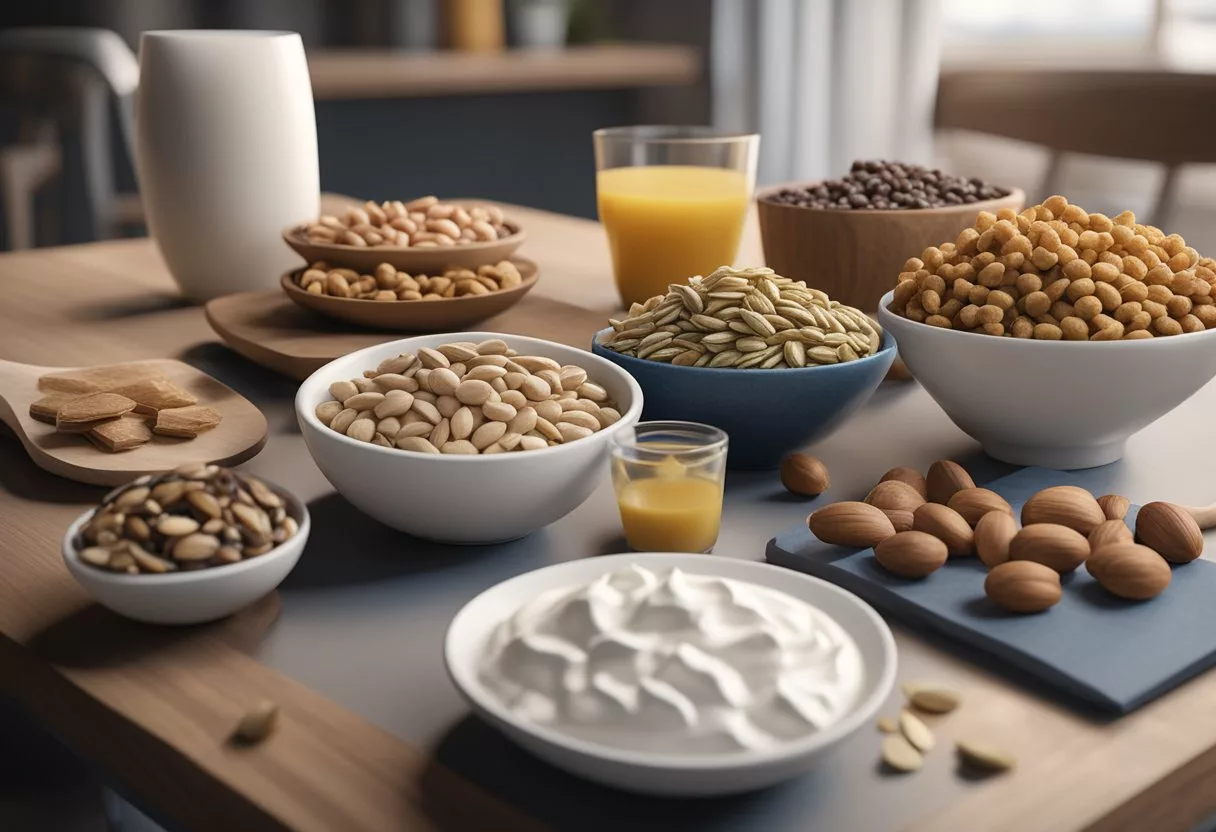
When they consume high-protein snacks, individuals often notice an increase in satiety, which refers to the feeling of fullness and the reduction of hunger between meals.
How Protein Increases Fullness
Protein is highly effective at inducing feelings of fullness, partly because it activates certain hormones that signal satiety to the brain.
For instance, it increases the levels of the satiety hormones like GLP-1 and PYY while decreasing the levels of the hunger hormone ghrelin. By doing so, it can extend the period of time that an individual feels full after eating.
Studies have consistently shown that diets higher in protein lead to greater satiety than diets lower in protein.
Snacks that Keep You Feeling Full Longer
Snacks high in protein and fiber are the primary contenders when it comes to prolonging satiety.
A single serving of these snacks often contains approximately 7 grams of protein or more, which can significantly impact the duration of fullness experienced.
For example, pairing fiber-rich black beans with salsa can be a simple yet satisfying choice, as stated by Diet Doctor (tasty high-satiety snacks).
Likewise, celery sticks with a spread of peanut butter provide a tasty combination of crunch and protein, making for a steady source of energy.
Other snacks such as roasted chickpeas not only offer protein but also a hefty dose of fiber – both of which contribute to the feeling of fullness for longer periods, as noted by Forbes (high-protein snacks).
Shopping and Storage Tips
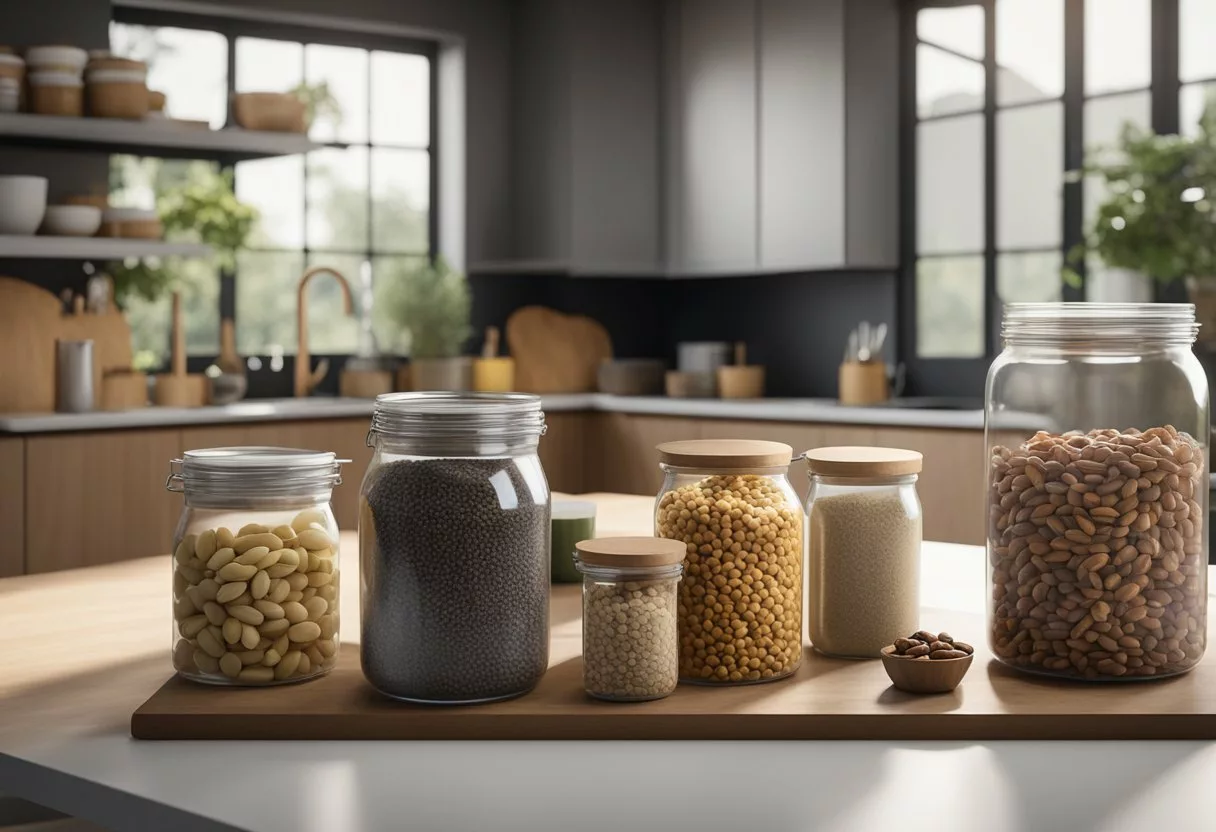
When looking for high-protein snacks, one should prioritize the quality of ingredients and understand their storage needs to maintain freshness and nutritional value.
Selecting High-Quality Ingredients
When shopping for ingredients, one should look for organic or all-natural labels to ensure they are free from unnecessary additives.
For example, choosing nuts like almonds or walnuts can provide a hefty protein boost.
It’s beneficial to check the nutritional information for protein content; snacks like roasted chickpeas are known for their high protein and fiber content.
Similarly, dairy products like Greek yogurt should have live and active cultures, indicating a good source of protein and probiotics.
Properly Storing Protein Snacks
Appropriate storage is key to preserving the quality and safety of high-protein snacks.
Nuts and seeds should be stored in airtight containers in a cool, dark place to prevent them from becoming rancid. Refrigeration can extend their shelf life.
For homemade snacks like peanut butter celery sticks, use airtight containers or wrap them tightly to prevent moisture loss and maintain freshness.
Snacks such as jerky or dried meats should be kept in cool, dry conditions and consumed by their use-by dates to ensure safety and quality.
Frequently Asked Questions
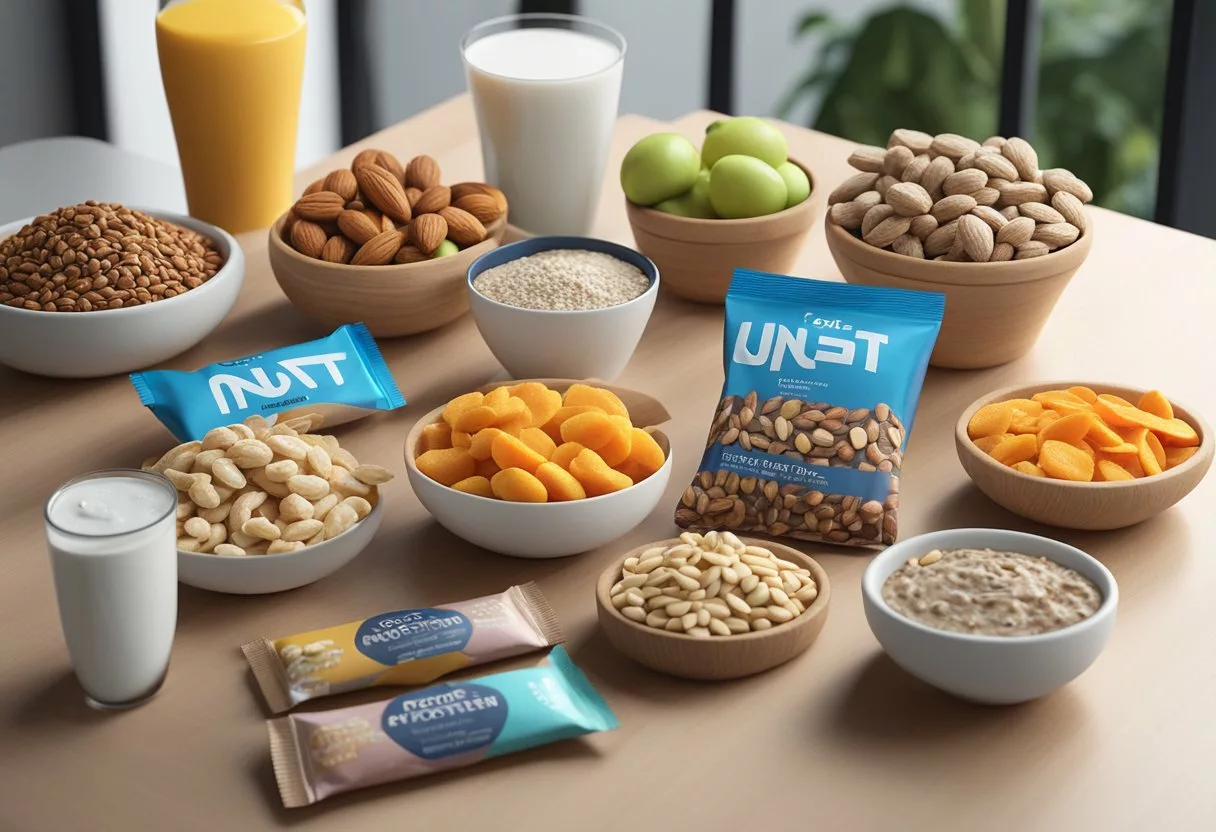
When considering protein-packed snacks for various health goals, it is essential to focus on options that combine nutritional value with convenience. The following questions address common concerns around incorporating high-protein snacks into one’s diet.
What are some high-protein snacks that can aid in weight loss?
Snacking on high-protein foods like Greek yogurt can help maintain muscle mass while promoting fat loss during calorie restriction. Another option is celery sticks with peanut butter, which provides satiety without excessive calories.
Can you suggest any high-protein snack recipes for muscle building?
For muscle building, a high-protein snack such as a smoothie with whey protein, banana, and almond milk can be both nourishing and muscle replenishing.
Alternatively, hard-boiled eggs are a convenient post-workout snack packed with essential amino acids.
What options are available for low-carb high-protein snacks?
Low-carb and high-protein snacks include options like cheese strings or jerky, which satisfy hunger without adding excessive carbohydrates.
Roasted chickpeas also make a crunchy, high-protein snack with minimal carbs.
What store-bought snacks are high in protein?
Many store-bought snacks offer a protein boost, such as protein bars or premade protein shakes.
When shopping for these, make sure to look for options with low sugar content to maximize health benefits.
What are some snacks under 100 calories that are rich in protein?
Snacks like hard-boiled eggs or a small serving of cottage cheese can provide a protein fix with few calories.
Being mindful of portion sizes ensures these snacks remain under the 100-calorie mark.
How can someone increase their daily protein intake to 100 grams through snacking?
To significantly increase protein intake through snacks, one could include multiple small portions of high-protein snacks throughout the day.
Combining a variety of snacks such as almonds, Greek yogurt, and protein shakes can help reach the target of 100 grams.